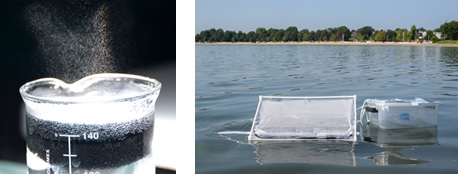Clean Water
Water is among the most vital natural resources for sustaining life on earth. Growing human populations and standards of living have created major stresses on the supply on fresh water, which is struggling to meet demand. There are already about 2.8 billion people living in water stressed areas. At the current growth rate, we will be consuming 90% of the available fresh water by 2025, by which time the population living in water stressed areas is expected to increase to 3.9 billion. As some people say, “water is the new oil.” This is especially true with global warming. Water technologies are inherently related to their energy consumption. We are developing innovative technologies in desalination and wastewater treatment.
Interfacial Solar Evaporation of Water
When sunlight shines on a pond, it penetrates deep into the water and hence does not raise the pond temperature much due to the low intensity of sunlight. We came up with the idea of floating a porous absorber on a water surface that is insulated thermally from the water underneath. This leads to a higher temperature of the porous absorber and significantly improves the water evaporation rate. We demonstrated that one can even produce superheated steam using this technique. These approaches have potential applications for wastewater treatment, seawater desalination, sterilization, and cooking. Our current work includes system development and further understanding the fundamental mechanisms underpinning these technologies, as others have reported hydrogel solar absorbers that can have apparently reduced latent heat.
 Floating Surface Solar Evaporator Structures
Floating Surface Solar Evaporator Structures
Key Publications
- Thomas Cooper, Seyed Hadi Zandavi, George Ni, Svetlana V. Boriskina, Gang Chen, "Contactless steam generation and superheating under one sun illumination," Nature Communications, 9, 5086, 2018.
- Peng Tao, George Ni, Chengyi Song, Wen Shang, Jianbo Wu, Jia Zhu, Gang Chen, Tao Deng, "Solar-driven evaporation," Nature Energy, 3, 1031-1041, 2018.
- George Ni, Gabriel Li, Svetlana V. Boriskina, Hongxia Li, Weilin Yang, TieJun Zhang, Gang Chen, "Steam Generation under One Sun enabled by a floating structure with thermal concentration", Nature Energy, 1, 16126, 2016.
- Hadi Ghasemi, Geroge Ni, Amy Marie Marconnet, James Loomis, Selcuk Yerci, Nenad Miljkovic, and Gang Chen, "Solar steam generation by heat localization", Nature Communications, 5, 4449, 2014.
Directional Solvent Extraction
We often say water and oil do not mix, although that is not completely true. It turns out some oils dissolve small amounts of water. Interestingly, when putting a saline droplet into oil, water can seep into the oil but salt cannot. We have exploited this phenomenon and the fact that the solubility of water in oil changes with temperature to invent a directional solvent extraction process for water desalination and wastewater treatment. This invention was selected by Scientific American as one of its top 10 World Changing Ideas. Graduate student Anurag Bajpayee moved on to start Gradiant Inc. with his RK labmate Prakash Govindan supervised by Professor John Lienhard.
 Directional Solvent Extraction Cycle for Desalination
Directional Solvent Extraction Cycle for Desalination
Key Publications
- Anurag Bajpayee, Tengfei Luo, Andrew Muto, and Gang Chen, “Very Low Temperature Membrane Free Desalination by Directional Solvent Extraction,” Energy and Environmental Science, 4, 1672-1675, 2011.
- Tengfei Luo, Anurag Bajpayee and Gang Chen, “Directional Solvent for Membrane-Free Water Desalination – A Molecular Level Study,” Journal of Applied Physics, 110, 054905, 2011.
Extracting Water From Air
Even though fresh water resources are shrinking, there is plenty of water in the air! How we can efficient extract water from air is an interesting challenge. We have started recently working on new materials and thermodynamic cycles that can efficiently extract water from air.